Climate Change Effects on Land Use and Land Cover Suitability in the Southern Brazilian Semiarid Region
Abstract
1. Introduction
2. Materials and Methods
2.1. Study Area
2.2. Methodological Approach
2.3. Covariates
2.4. Dataset
2.5. Training and Validation
2.6. Prediction Scenarios
3. Results
3.1. Climate Projections
3.2. Mapping LULC for the Historical Scenario (1970–2000) and Future Trends (2061–2080)
4. Discussion
4.1. Mapping Performance and the Covariate Influences
4.2. Impacts of Climate Change on LULC Classes
5. Conclusions
Author Contributions
Funding
Data Availability Statement
Conflicts of Interest
References
- Burrell, A.L.; Evans, J.P.; De Kauwe, M.G. Anthropogenic Climate Change Has Driven over 5 Million Km2 of Drylands Towards Desertification. Nat. Commun. 2020, 11, 3853. [Google Scholar] [CrossRef] [PubMed]
- Huang, J.; Yu, H.; Guan, X.; Wang, G.; Guo, R. Accelerated Dryland Expansion under Climate Change. Nat. Clim. Change 2016, 6, 166–171. [Google Scholar] [CrossRef]
- Huang, J.; Li, Y.; Fu, C.; Chen, F.; Fu, Q.; Dai, A.; Shinoda, M.; Ma, Z.; Guo, W.; Li, Z.; et al. Dryland Climate Change: Recent Progress and Challenges. Rev. Geophys. 2017, 55, 719–778. [Google Scholar] [CrossRef]
- Dale, V.H. The Relationship Between Land-Use Change and Climate Change. Ecol. Appl. 1997, 7, 753–769. [Google Scholar] [CrossRef]
- Malczewski, J. GIS-Based Land-Use Suitability Analysis: A Critical Overview. Prog. Plan. 2004, 62, 3–65. [Google Scholar] [CrossRef]
- Fernandes, M.F.; Cardoso, D.; de Queiroz, L.P. An Updated Plant Checklist of the Brazilian Caatinga Seasonally Dry Forests and Woodlands Reveals High Species Richness and Endemism. J. Arid Environ. 2020, 174, 104079. [Google Scholar] [CrossRef]
- Guillory, W.X.; de Medeiros Magalhães, F.; Coelho, F.E.A.; Bonatelli, I.A.S.; Palma-Silva, C.; Moraes, E.M.; Garda, A.A.; Burbrink, F.T.; Gehara, M. Geoclimatic Drivers of Diversification in the Largest Arid and Semi-Arid Environment of the Neotropics: Perspectives from Phylogeography. Mol. Ecol. 2024, 33, e17431. [Google Scholar] [CrossRef]
- Marengo, J.A.; Cunha, A.P.M.A.; Nobre, C.A.; Ribeiro Neto, G.G.; Magalhaes, A.R.; Torres, R.R.; Sampaio, G.; Alexandre, F.; Alves, L.M.; Cuartas, L.A.; et al. Assessing Drought in the Drylands of Northeast Brazil under Regional Warming Exceeding 4 °C. Nat. Hazards 2020, 103, 2589–2611. [Google Scholar] [CrossRef]
- Tomasella, J.; de Amaral Cunha, A.P.; Marengo, J.A. Nota Técnica: Elaboração Dos Mapas de Índice de Aridez e Precipitação Total Acumulada Para o Brasil. Brasília Minist. Ciênc. Tecnol. E Inov. 2023. Available online: https://www.gov.br/cemaden/pt-br/assuntos/noticias-cemaden/estudo-do-cemaden-e-do-inpe-identifica-pela-primeira-vez-a-ocorrencia-de-uma-regiao-arida-no-pais/nota-tecnica_aridas.pdf (accessed on 4 November 2024).
- de Castro Oliveira, G.; Arruda, D.M.; Fernandes Filho, E.I.; Veloso, G.V.; Francelino, M.R.; Schaefer, C.E.G.R. Soil Predictors Are Crucial for Modelling Vegetation Distribution and Its Responses to Climate Change. Sci. Total Environ. 2021, 780, 146680. [Google Scholar] [CrossRef]
- Maksic, J.; Venancio, I.M.; Shimizu, M.H.; Chiessi, C.M.; Piacsek, P.; Sampaio, G.; Cruz, F.W.; Alexandre, F.F. Brazilian Biomes Distribution: Past and Future. Palaeogeogr. Palaeoclimatol. Palaeoecol. 2022, 585, 110717. [Google Scholar] [CrossRef]
- Oliveira, A.C.P.; Nunes, A.; Oliveira, M.A.; Rodrigues, R.G.; Branquinho, C. How Do Taxonomic and Functional Diversity Metrics Change Along an Aridity Gradient in a Tropical Dry Forest? Front. Plant Sci. 2022, 13, 923219. [Google Scholar] [CrossRef] [PubMed]
- Burney, J.; Cesano, D.; Russell, J.; La Rovere, E.L.; Corral, T.; Coelho, N.S.; Santos, L. Climate Change Adaptation Strategies for Smallholder Farmers in the Brazilian Sertão. Clim. Change 2014, 126, 45–59. [Google Scholar] [CrossRef]
- Bigolin, T.; Talamini, E. Impacts of Climate Change Scenarios on the Corn and Soybean Double-Cropping System in Brazil. Climate 2024, 12, 42. [Google Scholar] [CrossRef]
- Noble, I.R. A Model of the Responses of Ecotones to Climate Change. Ecol. Appl. 1993, 3, 396–403. [Google Scholar] [CrossRef]
- Smith, A.J.; Goetz, E.M. Climate Change Drives Increased Directional Movement of Landscape Ecotones. Landsc. Ecol. 2021, 36, 3105–3116. [Google Scholar] [CrossRef]
- Arruda, D.M.; Ferreira-Júnior, W.G.; Duque-Brasil, R.; Schaefer, C.E.R. Phytogeographical Patterns of Dry Forests Sensu Stricto in Northern Minas Gerais State, Brazil. An. Acad. Bras. Ciênc. 2013, 85, 623–634. [Google Scholar] [CrossRef]
- Echternacht, L.; Trovó, M.; Oliveira, C.T.; Pirani, J.R. Areas of Endemism in the Espinhaço Range in Minas Gerais, Brazil. Flora-Morphol. Distrib. Funct. Ecol. Plants 2011, 206, 782–791. [Google Scholar] [CrossRef]
- Souza, A.P.; Corrêa, G.R.; Arruda, D.M.; Fonseca, R.S.; Candido, H.G.; Rosa, G.P.; Koch, V.A.; Rodrigues, A.P.D.; Xavier, M.V.B. Edaphic Gradient Shapes the Structure and Composition of Vegetation in the Forest-Cerrado Ecotone in North of Minas Gerais, Brazil. Braz. J. Bot. 2024. [Google Scholar] [CrossRef]
- Myers, N.; Mittermeier, R.A.; Mittermeier, C.G.; Da Fonseca, G.A.; Kent, J. Biodiversity Hotspots for Conservation Priorities. Nature 2000, 403, 853–858. [Google Scholar] [CrossRef]
- Oliveira, I.M.; Pereira, L.A.G. Geografia das Exportações de Frutas no Projeto Jaíba–MG: Transportes e interconexões com os mercados globais. Cad. Geogr. 2020, 30, 34–64. [Google Scholar] [CrossRef]
- Leite, M.E.; Almeida, J.W.L.; Silva, R.F. da Análise espaço-temporal do eucalipto no Norte de Minas Gerais nos anos de 1986, 1996 e 2010. GeoTextos 2012, 8, 59–74. [Google Scholar] [CrossRef][Green Version]
- Arruda, D.M.; Schaefer, C.E.G.R.; Fonseca, R.S.; Fernandes-Filho, E.I.; Veloso, G.V.; Gomes, L.C.; Oliveira, F.S.; Corrêa, G.R.; Espírito-Santo, M.M.; Oliveira, G.C.; et al. Amazonian Vegetation Types and Indigenous Lands Threatened by Upcoming Climate Change: Forecast Impact for Brazilian Biomes. Austral Ecol. 2024, 49, e13369. [Google Scholar] [CrossRef]
- Zeferino, L.B.; de Souza, L.F.T.; do Amaral, C.H.; Fernandes Filho, E.I.; de Oliveira, T.S. Does Environmental Data Increase the Accuracy of Land Use and Land Cover Classification? Int. J. Appl. Earth Obs. Geoinf. 2020, 91, 102128. [Google Scholar] [CrossRef]
- Bonannella, C.; Hengl, T.; Parente, L.; Bruin, S. de Biomes of the World under Climate Change Scenarios: Increasing Aridity and Higher Temperatures Lead to Significant Shifts in Natural Vegetation. PeerJ 2023, 11, e15593. [Google Scholar] [CrossRef]
- Hengl, T.; Walsh, M.G.; Sanderman, J.; Wheeler, I.; Harrison, S.P.; Prentice, I.C. Global Mapping of Potential Natural Vegetation: An Assessment of Machine Learning Algorithms for Estimating Land Potential. PeerJ 2018, 6, e5457. [Google Scholar] [CrossRef]
- Breiman, L. Random Forests. Mach. Learn. 2001, 45, 5–32. [Google Scholar] [CrossRef]
- Liaw, A.; Wiener, M. Classification and Regression by randomForest. R News 2002, 2, 18–22. [Google Scholar]
- IBGE. Censo Demográfico; IBGE: Rio de Janeiro, Brasil, 2010. [Google Scholar]
- Menezes, J.A.; Madureira, A.P.; dos Santos, R.B.; de Brito Duval, I.; Regoto, P.; Margonari, C.; de Lima Barata, M.M.; Confalonieri, U. Analyzing Spatial Patterns of Health Vulnerability to Drought in the Brazilian Semiarid Region. Int. J. Environ. Res. Public. Health 2021, 18, 6262. [Google Scholar] [CrossRef]
- Dupin, M.G.V.; Espírito-Santo, M.M.; Leite, M.E.; Silva, J.O.; Rocha, A.M.; Barbosa, R.S.; Anaya, F.C. Land Use Policies and Deforestation in Brazilian Tropical Dry Forests between 2000 and 2015. Environ. Res. Lett. 2018, 13, 035008. [Google Scholar] [CrossRef]
- Souza, C.M.P.; Almeida, M.I.S. Distribuição Geográfica Dos Solos e Relação Com Paisagens Do Norte de Minas Gerais. In A Geografia do Norte de Minas Gerais: Reflexões e Proposições; Entremares: São Paulo, Brasil, 2022; Volume 1, pp. 231–241. ISBN 978-65-87702-03-2. [Google Scholar]
- Alvares, C.A.; Stape, J.L.; Sentelhas, P.C.; de Moraes Gonçalves, J.L.; Sparovek, G. Köppen’s Climate Classification Map for Brazil. Meteorol. Z. 2013, 22, 711–728. [Google Scholar] [CrossRef] [PubMed]
- Espírito-Santo, M.M.; Sevilha, A.C.; Anaya, F.C.; Barbosa, R.; Fernandes, G.W.; Sanchez-Azofeifa, G.A.; Scariot, A.; de Noronha, S.E.; Sampaio, C.A. Sustainability of Tropical Dry Forests: Two Case Studies in Southeastern and Central Brazil. For. Ecol. Manag. 2009, 258, 922–930. [Google Scholar] [CrossRef]
- Silva, L.A.P.; Sena-Souza, J.P.; Souza, C.M.P.; Silva, C.R.; Bolfe, É.L.; Chagas-Reis, C.C.; Leite, M.E. Drivers of Degradation of Pastures in the Cerrado North of Minas Gerais-BR. RAEGA-O Espaço Geográfico Em Análise 2023, 57, 66–80. [Google Scholar] [CrossRef]
- Silva, L.A.P.; Bolfe, É.L.; Ferreira, M.E.; Veloso, G.A.; de Moura Laurentino, C.M.; Da Silva, C.R. Modelling the Pastureland Productivity in Areas of Savanna in Northern Minas Gerais. Caminhos Geogr. 2022, 23, 124–134. [Google Scholar] [CrossRef]
- Hijmans, R.J.; Cameron, S.E.; Parra, J.L.; Jones, P.G.; Jarvis, A. Very High Resolution Interpolated Climate Surfaces for Global Land Areas. Int. J. Climatol. J. R. Meteorol. Soc. 2005, 25, 1965–1978. [Google Scholar] [CrossRef]
- Fick, S.E.; Hijmans, R.J. WorldClim 2: New 1-Km Spatial Resolution Climate Surfaces for Global Land Areas. Int. J. Climatol. 2017, 37, 4302–4315. [Google Scholar] [CrossRef]
- IPCC. Climate Change 2014: Synthesis Report. In Contribution of Working Groups I, II and III to the Fifth Assessment Report of the Intergovernmental Panel on Climate Change; Pachauri, R.K., Meyer, L.A., Eds.; IPCC: Geneva, Switzerland, 2014. [Google Scholar]
- Zelinka, M.D.; Myers, T.A.; McCoy, D.T.; Po-Chedley, S.; Caldwell, P.M.; Ceppi, P.; Klein, S.A.; Taylor, K.E. Causes of Higher Climate Sensitivity in CMIP6 Models. Geophys. Res. Lett. 2020, 47, e2019GL085782. [Google Scholar] [CrossRef]
- Hofer, S.; Lang, C.; Amory, C.; Kittel, C.; Delhasse, A.; Tedstone, A.; Fettweis, X. Greater Greenland Ice Sheet Contribution to Global Sea Level Rise in CMIP6. Nat. Commun. 2020, 11, 6289. [Google Scholar] [CrossRef]
- Hausfather, Z.; Marvel, K.; Schmidt, G.A.; Nielsen-Gammon, J.W.; Zelinka, M. Climate Simulations: Recognize the ‘Hot Model’ Problem. Nature 2022, 605, 26–29. [Google Scholar] [CrossRef]
- Voosen, P. ‘Hot’ Climate Models Exaggerate Earth Impacts. Science 2022, 376, 685. [Google Scholar] [CrossRef]
- Zhao, Q.; Zhu, Z.; Zeng, H.; Zhao, W.; Myneni, R.B. Future Greening of the Earth May Not Be as Large as Previously Predicted. Agric. For. Meteorol. 2020, 292–293, 108111. [Google Scholar] [CrossRef]
- Müller, C.; Franke, J.; Jägermeyr, J.; Ruane, A.C.; Elliott, J.; Moyer, E.; Heinke, J.; Falloon, P.D.; Folberth, C.; Francois, L.; et al. Exploring Uncertainties in Global Crop Yield Projections in a Large Ensemble of Crop Models and CMIP5 and CMIP6 Climate Scenarios. Environ. Res. Lett. 2021, 16, 034040. [Google Scholar] [CrossRef]
- Song, X.; Wang, D.-Y.; Li, F.; Zeng, X.-D. Evaluating the Performance of CMIP6 Earth System Models in Simulating Global Vegetation Structure and Distribution. Adv. Clim. Change Res. 2021, 12, 584–595. [Google Scholar] [CrossRef]
- Yuan, W.; Wu, S.-Y.; Hou, S.; Xu, Z.; Pang, H.; Lu, H. Projecting Future Vegetation Change for Northeast China Using CMIP6 Model. Remote Sens. 2021, 13, 3531. [Google Scholar] [CrossRef]
- Liu, J.; Lu, Y. How Well Do CMIP6 Models Simulate the Greening of the Tibetan Plateau? Remote Sens. 2022, 14, 4633. [Google Scholar] [CrossRef]
- Santos, J.F.; Schickhoff, U.; ul Hasson, S.; Böhner, J. Biogeophysical Effects of Land-Use and Land-Cover Changes in South Asia: An Analysis of CMIP6 Models. Land 2023, 12, 880. [Google Scholar] [CrossRef]
- Navarro, A.; Lee, G.; Martín, R.; Tapiador, F.J. Uncertainties in Measuring Precipitation Hinders Precise Evaluation of Loss of Diversity in Biomes and Ecotones. Npj Clim. Atmos. Sci. 2024, 7, 35. [Google Scholar] [CrossRef]
- Xiao, Y.; Chen, T.; Chen, X.; Yang, Y.; Wang, S.; Zhou, S. CMIP6 ESMs Overestimate Greening and the Photosynthesis Trends in Dryland East Asia. Sci. Total Environ. 2024, 937, 173432. [Google Scholar] [CrossRef]
- Zilli, M.; Scarabello, M.; Soterroni, A.C.; Valin, H.; Mosnier, A.; Leclère, D.; Havlík, P.; Kraxner, F.; Lopes, M.A.; Ramos, F.M. The Impact of Climate Change on Brazil’s Agriculture. Sci. Total Environ. 2020, 740, 139384. [Google Scholar] [CrossRef]
- Allen, B.J.; Hill, D.J.; Burke, A.M.; Clark, M.; Marchant, R.; Stringer, L.C.; Williams, D.R.; Lyon, C. Projected Future Climatic Forcing on the Global Distribution of Vegetation Types. Philos. Trans. R. Soc. B Biol. Sci. 2024, 379, 20230011. [Google Scholar] [CrossRef]
- Tovar, C.; Carril, A.F.; Gutiérrez, A.G.; Ahrends, A.; Fita, L.; Zaninelli, P.; Flombaum, P.; Abarzúa, A.M.; Alarcón, D.; Aschero, V.; et al. Understanding Climate Change Impacts on Biome and Plant Distributions in the Andes: Challenges and Opportunities. J. Biogeogr. 2022, 49, 1420–1442. [Google Scholar] [CrossRef] [PubMed]
- Leão, T.C.C.; Reinhardt, J.R.; Nic Lughadha, E.; Reich, P.B. Projected Impacts of Climate and Land Use Changes on the Habitat of Atlantic Forest Plants in Brazil. Glob. Ecol. Biogeogr. 2021, 30, 2016–2028. [Google Scholar] [CrossRef]
- Costa, T.R.; Da Silva, L.A.; De Moura, C.C.; De Souto Azevedo, C.H.; Bueno, M.L.; Mucida, D.P.; Santos, T.; Gonzaga, A.P.D. Vulnerability of the Cerrado–Atlantic Forest Ecotone in the Espinhaço Range Biosphere Reserve to Climate Change. Theor. Appl. Climatol. 2023, 151, 1151–1170. [Google Scholar] [CrossRef]
- Gent, P.R.; Danabasoglu, G.; Donner, L.J.; Holland, M.M.; Hunke, E.C.; Jayne, S.R.; Lawrence, D.M.; Neale, R.B.; Rasch, P.J.; Vertenstein, M.; et al. The Community Climate System Model Version 4. J. Clim. 2011, 24, 4973–4991. [Google Scholar] [CrossRef]
- Gutjahr, O.; Putrasahan, D.; Lohmann, K.; Jungclaus, J.H.; von Storch, J.-S.; Brüggemann, N.; Haak, H.; Stössel, A. Max Planck Institute Earth System Model (MPI-ESM1.2) for the High-Resolution Model Intercomparison Project (HighResMIP). Geosci. Model Dev. 2019, 12, 3241–3281. [Google Scholar] [CrossRef]
- Watanabe, S.; Hajima, T.; Sudo, K.; Nagashima, T.; Takemura, T.; Okajima, H.; Nozawa, T.; Kawase, H.; Abe, M.; Yokohata, T.; et al. MIROC-ESM 2010: Model Description and Basic Results of CMIP5-20c3m Experiments. Geosci. Model Dev. 2011, 4, 845–872. [Google Scholar] [CrossRef]
- Anjos, L.J.S.; Barreiros de Souza, E.; Amaral, C.T.; Igawa, T.K.; Mann de Toledo, P. Future Projections for Terrestrial Biomes Indicate Widespread Warming and Moisture Reduction in Forests up to 2100 in South America. Glob. Ecol. Conserv. 2021, 25, e01441. [Google Scholar] [CrossRef]
- Beigaitė, R.; Tang, H.; Bryn, A.; Skarpaas, O.; Stordal, F.; Bjerke, J.W.; Žliobaitė, I. Identifying Climate Thresholds for Dominant Natural Vegetation Types at the Global Scale Using Machine Learning: Average Climate versus Extremes. Glob. Change Biol. 2022, 28, 3557–3579. [Google Scholar] [CrossRef]
- Poggio, L.; Sousa, L.M.D.; Batjes, N.H.; Heuvelink, G.B.M.; Kempen, B.; Ribeiro, E.; Rossiter, D. SoilGrids 2.0: Producing Soil Information for the Globe with Quantified Spatial Uncertainty. SOIL 2021, 7, 217–240. [Google Scholar] [CrossRef]
- de Castro Oliveira, G.; Francelino, M.R.; Arruda, D.M.; Fernandes-Filho, E.I.; Schaefer, C.E.G.R. Climate and Soils at the Brazilian Semiarid and the Forest-Caatinga Problem: New Insights and Implications for Conservation. Environ. Res. Lett. 2019, 14, 104007. [Google Scholar] [CrossRef]
- Silva, R.C.; Corrêa, G.R.; Arruda, D.M.; Veloso, G.V.; Fernandes-Filho, E.I.; Cândido, H.G.; de Oliveira, F.S.; Rosa, G.P.; Behling, H.; Schaefer, C.E.G.R. The Brazilian Semiarid Region over the Past 21,000 Years: Vegetation Dynamics in Small Pulses of Higher Humidity. Ecol. Inform. 2023, 77, 102259. [Google Scholar] [CrossRef]
- Van Zyl, J.J. The Shuttle Radar Topography Mission (SRTM): A Breakthrough in Remote Sensing of Topography. Acta Astronaut. 2001, 48, 559–565. [Google Scholar] [CrossRef]
- Burnett, B.N.; Meyer, G.A.; McFadden, L.D. Aspect-Related Microclimatic Influences on Slope Forms and Processes, Northeastern Arizona. J. Geophys. Res. Earth Surf. 2008, 113, 002, F03002. [Google Scholar] [CrossRef]
- Huang, Y.-M.; Liu, D.; An, S.-S. Effects of Slope Aspect on Soil Nitrogen and Microbial Properties in the Chinese Loess Region. CATENA 2015, 125, 135–145. [Google Scholar] [CrossRef]
- Casanova, M.; Messing, I.; Joel, A. Influence of Aspect and Slope Gradient on Hydraulic Conductivity Measured by Tension Infiltrometer. Hydrol. Process. 2000, 14, 155–164. [Google Scholar] [CrossRef]
- Souza, C.M., Jr.; Shimbo, J.Z.; Rosa, M.R.; Parente, L.L.; Alencar, A.A.; Rudorff, B.F.T.; Hasenack, H.; Matsumoto, M.; Ferreira, L.G.; Souza-Filho, P.W.M.; et al. Reconstructing Three Decades of Land Use and Land Cover Changes in Brazilian Biomes with Landsat Archive and Earth Engine. Remote Sens. 2020, 12, 2735. [Google Scholar] [CrossRef]
- Projeto Mapbiomas. Pontos de Validação. 2023. Available online: https://brasil.mapbiomas.org/pontos-de-validacao/ (accessed on 4 November 2024).
- QGIS Spatial Without Compromise · QGIS Web Site. Available online: https://www.qgis.org/ (accessed on 20 August 2024).
- Rodriguez-Galiano, V.F.; Ghimire, B.; Rogan, J.; Chica-Olmo, M.; Rigol-Sanchez, J.P. An Assessment of the Effectiveness of a Random Forest Classifier for Land-Cover Classification. ISPRS J. Photogramm. Remote Sens. 2012, 67, 93–104. [Google Scholar] [CrossRef]
- Probst, P.; Wright, M.N.; Boulesteix, A.-L. Hyperparameters and Tuning Strategies for Random Forest. WIREs Data Min. Knowl. Discov. 2019, 9, e1301. [Google Scholar] [CrossRef]
- Kuhn, M.; Wing, J.; Weston, S.; Williams, A.; Keefer, C.; Engelhardt, A.; Cooper, T.; Mayer, Z.; Kenkel, B.; Team, R.C. Package ‘Caret’. R J. 2020, 223, 7. [Google Scholar]
- Pontius, R.G.; Millones, M. Death to Kappa: Birth of Quantity Disagreement and Allocation Disagreement for Accuracy Assessment. Int. J. Remote Sens. 2011, 32, 4407–4429. [Google Scholar] [CrossRef]
- Team, R.C. R: A Language and Environment for Statistical Computing; R Foundation for Statistical Computing: Vienna, Austria, 2022; Available online: https://www.r-project.org/ (accessed on 4 November 2024).
- Hijmans, R.J.; Van Etten, J.; Cheng, J.; Mattiuzzi, M.; Sumner, M.; Greenberg, J.A.; Lamigueiro, O.P.; Bevan, A.; Racine, E.B.; Shortridge, A. Package ‘Raster’. R Package 2015, 734, 473. [Google Scholar]
- Vaca, R.A.; Golicher, D.J.; Cayuela, L. Using Climatically Based Random Forests to Downscale Coarse-Grained Potential Natural Vegetation Maps in Tropical Mexico. Appl. Veg. Sci. 2011, 14, 388–401. [Google Scholar] [CrossRef]
- Keane, R.E.; Holsinger, L.M.; Loehman, R. Bioclimatic Modeling of Potential Vegetation Types as an Alternative to Species Distribution Models for Projecting Plant Species Shifts Under Changing Climates. For. Ecol. Manag. 2020, 477, 118498. [Google Scholar] [CrossRef]
- Leite, M.E.; Souza, C.M.P.; Silva, L.A.P. Dinâmica de Uso Da Terra No Norte de Minas—Sudeste Do Brasil. In A Geografia do Norte de Minas Gerais: Reflexões e Proposições; Entremares: São Paulo, Brasil, 2022; pp. 165–177. ISBN 978-65-87702-03-2. [Google Scholar]
- Hurskainen, P.; Adhikari, H.; Siljander, M.; Pellikka, P.K.E.; Hemp, A. Auxiliary Datasets Improve Accuracy of Object-Based Land Use/Land Cover Classification in Heterogeneous Savanna Landscapes. Remote Sens. Environ. 2019, 233, 111354. [Google Scholar] [CrossRef]
- Yi, S.; Zhou, J.; Lai, L.; Du, H.; Sun, Q.; Yang, L.; Liu, X.; Liu, B.; Zheng, Y. Simulating Highly Disturbed Vegetation Distribution: The Case of China’s Jing-Jin-Ji Region. PeerJ 2020, 8, e9839. [Google Scholar] [CrossRef]
- Konapala, G.; Mishra, A.K.; Wada, Y.; Mann, M.E. Climate Change Will Affect Global Water Availability through Compounding Changes in Seasonal Precipitation and Evaporation. Nat. Commun. 2020, 11, 3044. [Google Scholar] [CrossRef]
- Kuhn, M.; Johnson, K. Applied Predictive Modeling; Springer: New York, NY, USA, 2013; Volume 26. [Google Scholar]
- Liu, Y.; Geng, X.; Hao, Z.; Zheng, J. Changes in Climate Extremes in Central Asia under 1.5 and 2 °C Global Warming and Their Impacts on Agricultural Productions. Atmosphere 2020, 11, 1076. [Google Scholar] [CrossRef]
- Lopez, G.; Gaiser, T.; Ewert, F.; Srivastava, A. Effects of Recent Climate Change on Maize Yield in Southwest Ecuador. Atmosphere 2021, 12, 299. [Google Scholar] [CrossRef]
- Emam, A.R.; Kappas, M.; Hosseini, S.Z. Assessing the Impact of Climate Change on Water Resources, Crop Production and Land Degradation in a Semi-Arid River Basin. Hydrol. Res. 2015, 46, 854–870. [Google Scholar] [CrossRef]
- Tan, L.; Feng, P.; Li, B.; Huang, F.; Liu, D.L.; Ren, P.; Liu, H.; Srinivasan, R.; Chen, Y. Climate Change Impacts on Crop Water Productivity and Net Groundwater Use Under a Double-Cropping System with Intensive Irrigation in the Haihe River Basin, China. Agric. Water Manag. 2022, 266, 107560. [Google Scholar] [CrossRef]
- Worqlul, A.W.; Dile, Y.T.; Jeong, J.; Adimassu, Z.; Lefore, N.; Gerik, T.; Srinivasan, R.; Clarke, N. Effect of Climate Change on Land Suitability for Surface Irrigation and Irrigation Potential of the Shallow Groundwater in Ghana. Comput. Electron. Agric. 2019, 157, 110–125. [Google Scholar] [CrossRef]
- Gao, Y.; Zhang, A.; Yue, Y.; Wang, J.; Su, P. Predicting Shifts in Land Suitability for Maize Cultivation Worldwide Due to Climate Change: A Modeling Approach. Land 2021, 10, 295. [Google Scholar] [CrossRef]
- Akpoti, K.; Groen, T.; Dossou-Yovo, E.; Kabo-bah, A.T.; Zwart, S.J. Climate Change-Induced Reduction in Agricultural Land Suitability of West-Africa’s Inland Valley Landscapes. Agric. Syst. 2022, 200, 103429. [Google Scholar] [CrossRef]
- Mogonong, B.P.; Twine, W.; Feig, G.T.; Van der Merwe, H.; Fisher, J.T. Influences of Climate Variability on Land Use and Land Cover Change in Rural South Africa. Remote Sens. 2024, 16, 1200. [Google Scholar] [CrossRef]
- Oliveira, D.M.S.; Santos, R.S.; Chizzotti, F.H.M.; Bretas, I.L.; Franco, A.L.C.; Lima, R.P.; Freitas, D.A.F.; Cherubin, M.R.; Cerri, C.E.P. Crop, Livestock, and Forestry Integration to Reconcile Soil Health, Food Production, and Climate Change Mitigation in the Brazilian Cerrado: A Review. Geoderma Reg. 2024, 37, e00796. [Google Scholar] [CrossRef]
- Sone, J.S.; Sanches de Oliveira, P.T.; Pereira Zamboni, P.A.; Motta Vieira, N.O.; Altrão Carvalho, G.; Motta Macedo, M.C.; Romeiro de Araujo, A.; Baptaglin Montagner, D.; Alves Sobrinho, T. Effects of Long-Term Crop-Livestock-Forestry Systems on Soil Erosion and Water Infiltration in a Brazilian Cerrado Site. Sustainability 2019, 11, 5339. [Google Scholar] [CrossRef]
- Assad, E.D.; Calmon, M.; Lopes-Assad, M.L.; Feltran-Barbieri, R.; Pompeu, J.; Domingues, L.M.; Nobre, C.A. Adaptation and Resilience of Agricultural Systems to Local Climate Change and Extreme Events: An Integrative Review. Pesqui. Agropecuária Trop. 2022, 52, e72899. [Google Scholar] [CrossRef]
- Godde, C.M.; Garnett, T.; Thornton, P.K.; Ash, A.J.; Herrero, M. Grazing Systems Expansion and Intensification: Drivers, Dynamics, and Trade-Offs. Glob. Food Secur. 2018, 16, 93–105. [Google Scholar] [CrossRef]
- Nunes, F.S.M.; Soares-Filho, B.S.; Rajão, R.; Merry, F. Enabling Large-Scale Forest Restoration in Minas Gerais State, Brazil. Environ. Res. Lett. 2017, 12, 044022. [Google Scholar] [CrossRef]
- Fernandes, G.W.; Arantes-Garcia, L.; Barbosa, M.; Barbosa, N.P.U.; Batista, E.K.L.; Beiroz, W.; Resende, F.M.; Abrahão, A.; Almada, E.D.; Alves, E.; et al. Biodiversity and Ecosystem Services in the Campo Rupestre: A Road Map for the Sustainability of the Hottest Brazilian Biodiversity Hotspot. Perspect. Ecol. Conserv. 2020, 18, 213–222. [Google Scholar] [CrossRef]
- da Silva, L.A.P.; Rocha, A.M.; da Silva, C.R. Surface Temperature Behavior in View of the Conversion of Tropical Dry Forest into Anthropic Uses, Northern Minas Gerais–Brazil. PLoS ONE 2022, 17, e0270991. [Google Scholar] [CrossRef] [PubMed]
- Clemente, C.M.S.; do Espírito-Santo, M.M.; Leite, M.E. Estimates of Deforestation Avoided by Protected Areas: A Case Study in Brazilian Tropical Dry Forests and Cerrado. Landsc. Res. 2020, 45, 470–483. [Google Scholar] [CrossRef]
- do Espírito-Santo, M.M.; Rocha, A.M.; Leite, M.E.; Silva, J.O.; Silva, L.A.P.; Sanchez-Azofeifa, G.A. Biophysical and Socioeconomic Factors Associated to Deforestation and Forest Recovery in Brazilian Tropical Dry Forests. Front. For. Glob. Change 2020, 3, 569184. [Google Scholar] [CrossRef]
- Simpkin, P.; Cramer, L.K.; Ericksen, P.J.; Thornton, P.K. Current Situation and Plausible Future Scenarios for Livestock Management Systems under Climate Change in Africa. CGIAR Res. Program Clim. Change Agric. Food Secur. CCAFS 2020, 307, 3–71. [Google Scholar]
- Sousa, F.P.; Ferreira, T.O.; Mendonça, E.S.; Romero, R.E.; Oliveira, J.G.B. Carbon and Nitrogen in Degraded Brazilian Semi-Arid Soils Undergoing Desertification. Agric. Ecosyst. Environ. 2012, 148, 11–21. [Google Scholar] [CrossRef]
- Espírito-Santo, M.M.; Leite, M.E.; Silva, J.O.; Barbosa, R.S.; Rocha, A.M.; Anaya, F.C.; Dupin, M.G.V. Understanding Patterns of Land-Cover Change in the Brazilian Cerrado from 2000 to 2015. Philos. Trans. R. Soc. B Biol. Sci. 2016, 371, 20150435. [Google Scholar] [CrossRef]
- Strassburg, B.B.N.; Latawiec, A.E.; Barioni, L.G.; Nobre, C.A.; da Silva, V.P.; Valentim, J.F.; Vianna, M.; Assad, E.D. When Enough Should Be Enough: Improving the Use of Current Agricultural Lands Could Meet Production Demands and Spare Natural Habitats in Brazil. Glob. Environ. Change 2014, 28, 84–97. [Google Scholar] [CrossRef]
- Ribeiro, J.F.; Walter, B.M.T. Fitofisionomias do bioma cerrado. In Cerrado Ecologia e Flora, 1; Sano, S.M., Almeida, S.P., Ribeiro, J.F., Eds.; Embrapa: Planaltina, Brazil, 2008; pp. 152–212. [Google Scholar]
- Salazar, L.F.; Nobre, C.A.; Oyama, M.D. Climate Change Consequences on the Biome Distribution in Tropical South America. Geophys. Res. Lett. 2007, 34, L09708. [Google Scholar] [CrossRef]
- Terra, M.C.N.S.; Nunes, M.H.; Souza, C.R.; Ferreira, G.W.D.; do Prado-Junior, J.A.; Rezende, V.L.; Maciel, R.; Mantovani, V.; Rodrigues, A.; Morais, V.A.; et al. The Inverted Forest: Aboveground and Notably Large Belowground Carbon Stocks and Their Drivers in Brazilian Savannas. Sci. Total Environ. 2023, 867, 161320. [Google Scholar] [CrossRef]
- Araújo, I.; Marimon, B.S.; Scalon, M.C.; Cruz, W.J.A.; Fauset, S.; Vieira, T.C.S.; Galbraith, D.R.; Gloor, M.U. Intraspecific Variation in Leaf Traits Facilitates the Occurrence of Trees at the Amazonia–Cerrado Transition. Flora 2021, 279, 151829. [Google Scholar] [CrossRef]
- de Castro Nunes Santos Terra, M.; dos Santos, R.M.; do Prado Júnior, J.A.; de Mello, J.M.; Scolforo, J.R.S.; Fontes, M.A.L.; Schiavini, I.; dos Reis, A.A.; Bueno, I.T.; Magnago, L.F.S.; et al. Water Availability Drives Gradients of Tree Diversity, Structure and Functional Traits in the Atlantic–Cerrado–Caatinga Transition, Brazil. J. Plant Ecol. 2018, 11, 803–814. [Google Scholar] [CrossRef]
- Silva, L.A.; de Souza, C.M.P.; Leite, M.E.; Filgueiras, R. Estimativa da Perda de Água Na APA do Rio Pandeiros, Minas Gerais. Cad. Geogr. 2020, 30, 768–787. [Google Scholar] [CrossRef]
- Williams, A.P.; Allen, C.D.; Millar, C.I.; Swetnam, T.W.; Michaelsen, J.; Still, C.J.; Leavitt, S.W. Forest Responses to Increasing Aridity and Warmth in the Southwestern United States. Proc. Natl. Acad. Sci. USA 2010, 107, 21289–21294. [Google Scholar] [CrossRef] [PubMed]
- Anadón, J.D.; Sala, O.E.; Maestre, F.T. Climate Change Will Increase Savannas at the Expense of Forests and Treeless Vegetation in Tropical and Subtropical Americas. J. Ecol. 2014, 102, 1363–1373. [Google Scholar] [CrossRef]
- Costa, L.R.F.D. Considerações sobre as Macrounidades Geomorfológicas do estado de Minas Gerais–Brasil. William Morris Davis-Rev. Geomorfol. 2021, 2, 1–9. [Google Scholar] [CrossRef]
- Sales, L.P.; Pires, M.M. Identifying Climate Change Refugia for South American Biodiversity. Conserv. Biol. 2023, 37, e14087. [Google Scholar] [CrossRef]
- Fernandes, G.W.; Barbosa, N.P.U.; Negreiros, D.; Paglia, A.P. Challenges for the Conservation of Vanishing Megadiverse Rupestrian Grasslands. Perspect. Ecol. Conserv. 2014, 12, 162–165. [Google Scholar] [CrossRef]
- McDowell, N.G.; Beerling, D.J.; Breshears, D.D.; Fisher, R.A.; Raffa, K.F.; Stitt, M. The Interdependence of Mechanisms Underlying Climate-Driven Vegetation Mortality. Trends Ecol. Evol. 2011, 26, 523–532. [Google Scholar] [CrossRef]
- Hatfield, J.L.; Prueger, J.H. Temperature Extremes: Effect on Plant Growth and Development. Weather Clim. Extrem. 2015, 10, 4–10. [Google Scholar] [CrossRef]
- Florêncio, G.W.L.; Martins, F.B.; Fagundes, F.F.A. Climate Change on Eucalyptus Plantations and Adaptive Measures for Sustainable Forestry Development across Brazil. Ind. Crops Prod. 2022, 188, 115538. [Google Scholar] [CrossRef]
- Sondermann, M.; Chou, S.C.; Lyra, A.; Latinovic, D.; Siqueira, G.C.; Junior, W.C.; Giornes, E.; Leite, F.P. Climate Change Projections and Impacts on the Eucalyptus Plantation around the Doce River Basin, in Minas Gerais, Brazil. Clim. Serv. 2022, 28, 100327. [Google Scholar] [CrossRef]
- Resquin, F.; Duque-Lazo, J.; Acosta-Muñoz, C.; Rachid-Casnati, C.; Carrasco-Letelier, L.; Navarro-Cerrillo, R.M. Modelling Current and Future Potential Habitats for Plantations of Eucalyptus Grandis Hill Ex Maiden and E. Dunnii Maiden in Uruguay. Forests 2020, 11, 948. [Google Scholar] [CrossRef]
- Elli, E.F.; Sentelhas, P.C.; Bender, F.D. Impacts and Uncertainties of Climate Change Projections on Eucalyptus Plantations Productivity across Brazil. For. Ecol. Manag. 2020, 474, 118365. [Google Scholar] [CrossRef]
- Soares, M.P.; Nunes, Y.R.F. Regeneração natural de cerrado sob plantio de Eucalyptus camaldulensis Dehn. no norte de Minas Gerais, Brasil. Rev. Ceres 2013, 60, 205–214. [Google Scholar] [CrossRef]
- de Almeida, J.W.L.; Leite, M.E.; Figueiredo, L.H.A.; Figueiredo, M.A.P. Unidade de Conservação No Semiárido Mineiro e Seu Papel Na Preservação Ambiental. Cad. Geogr. 2023, 33, 1257–1276. [Google Scholar] [CrossRef]
- Afonso, R.; Miller, D.C. Forest Plantations and Local Economic Development: Evidence from Minas Gerais, Brazil. For. Policy Econ. 2021, 133, 102618. [Google Scholar] [CrossRef]
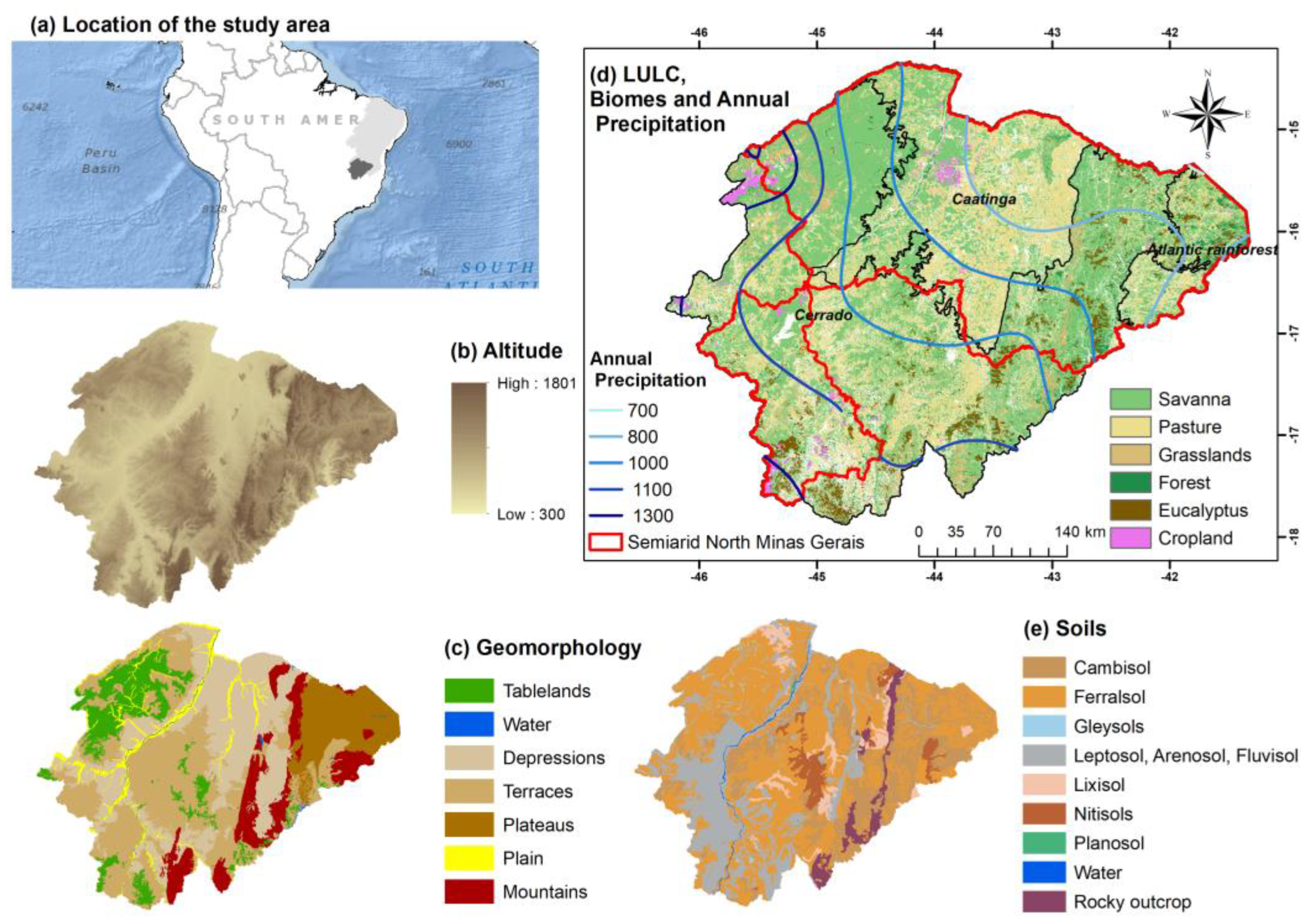
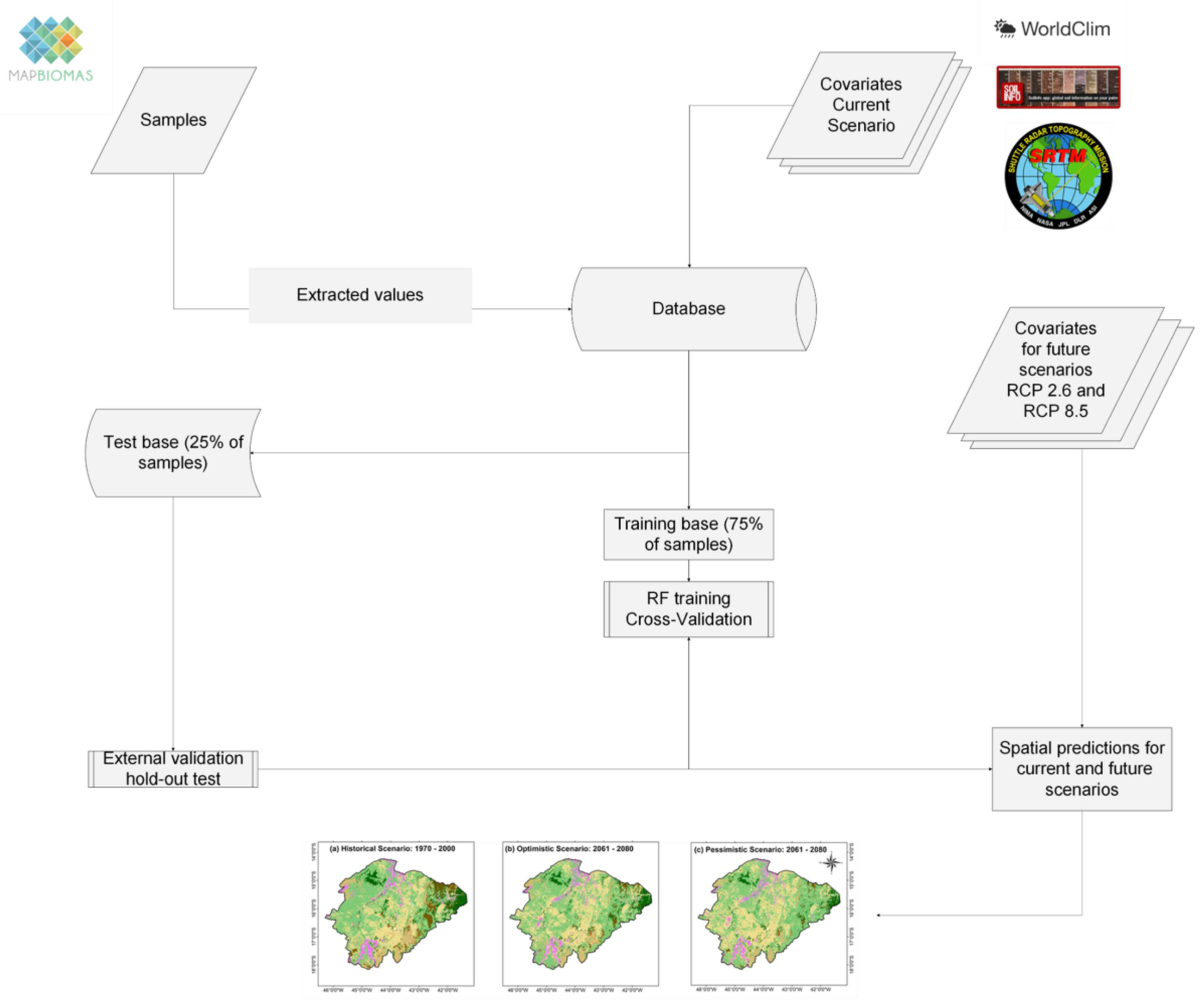
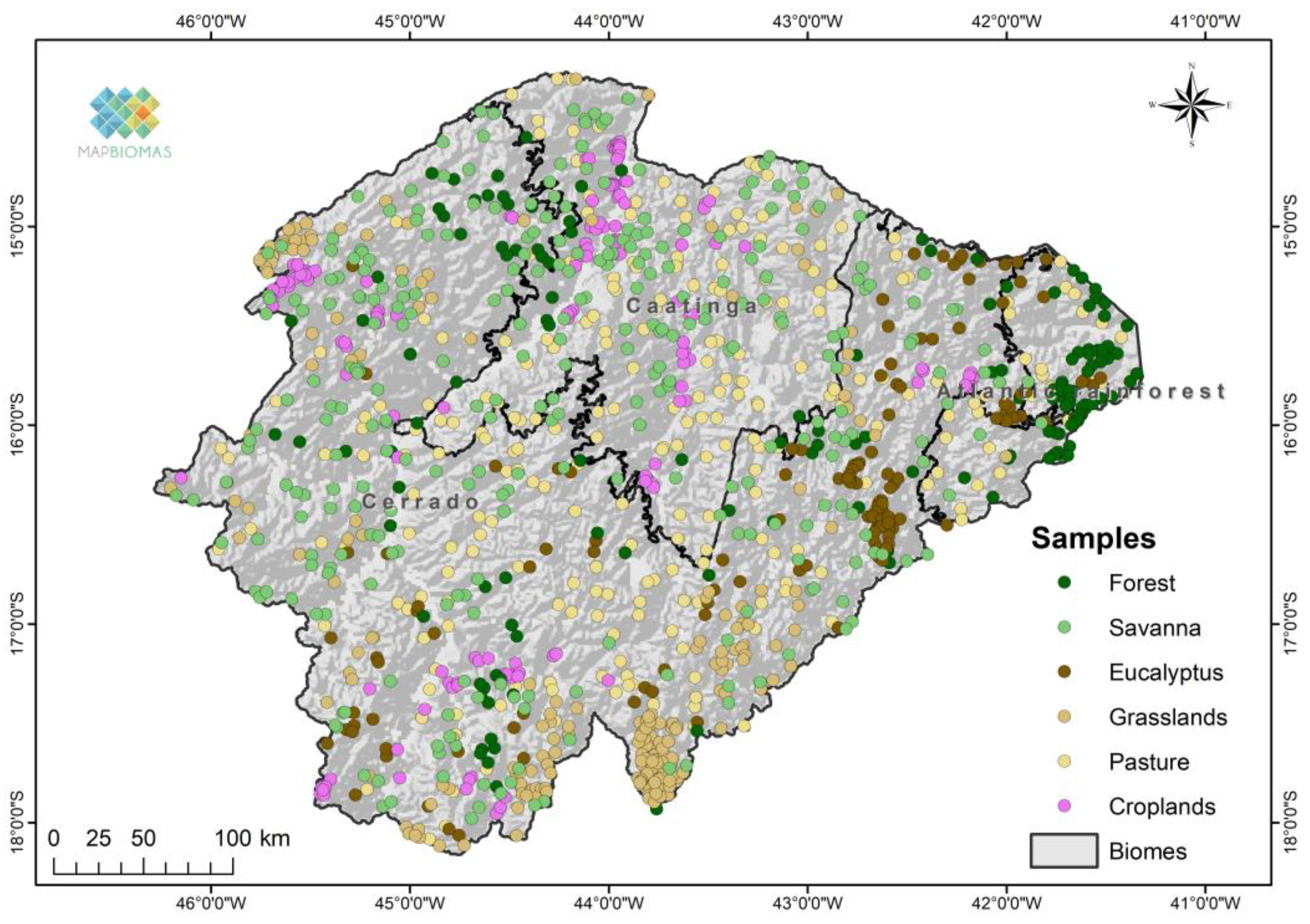
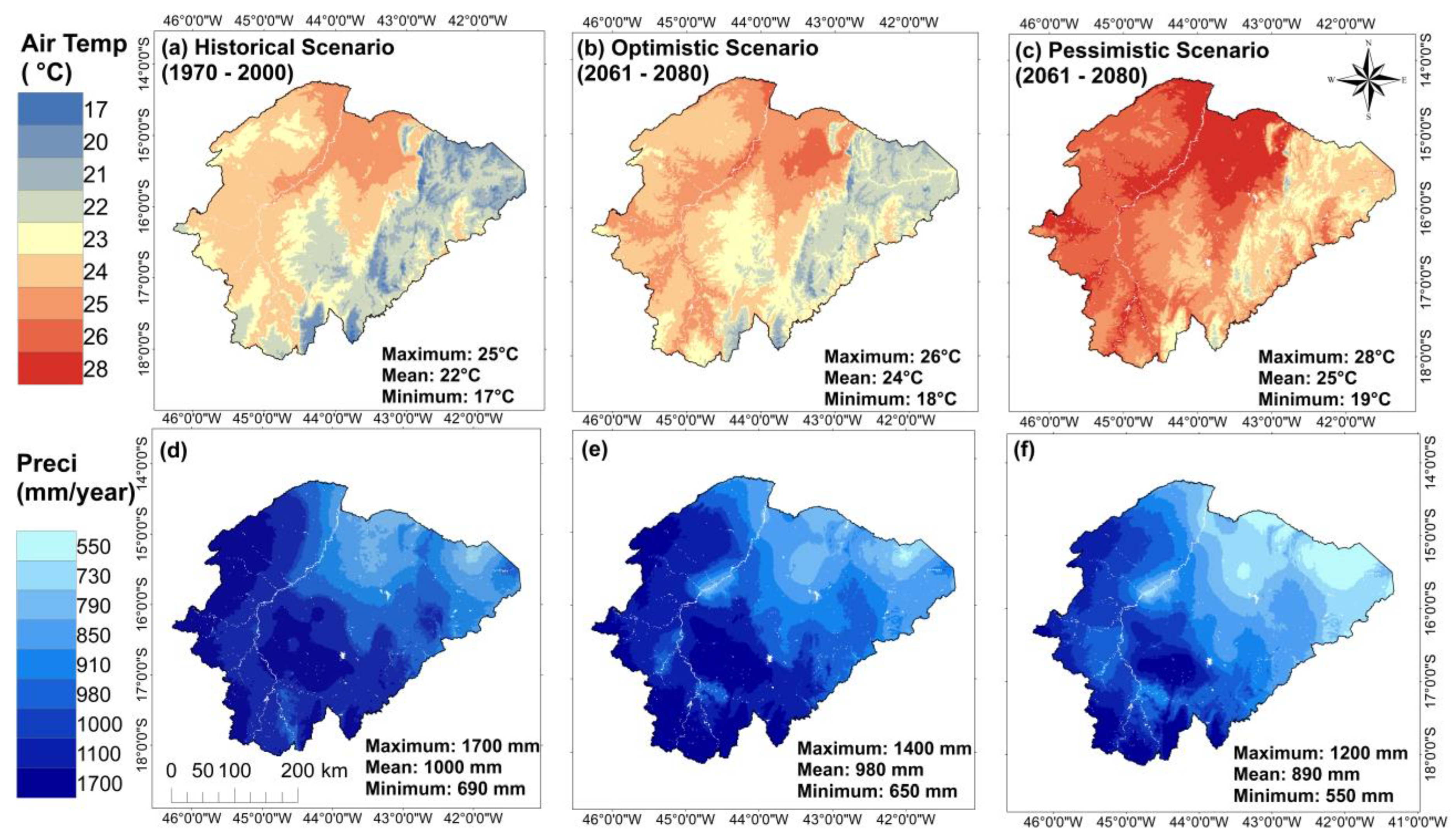
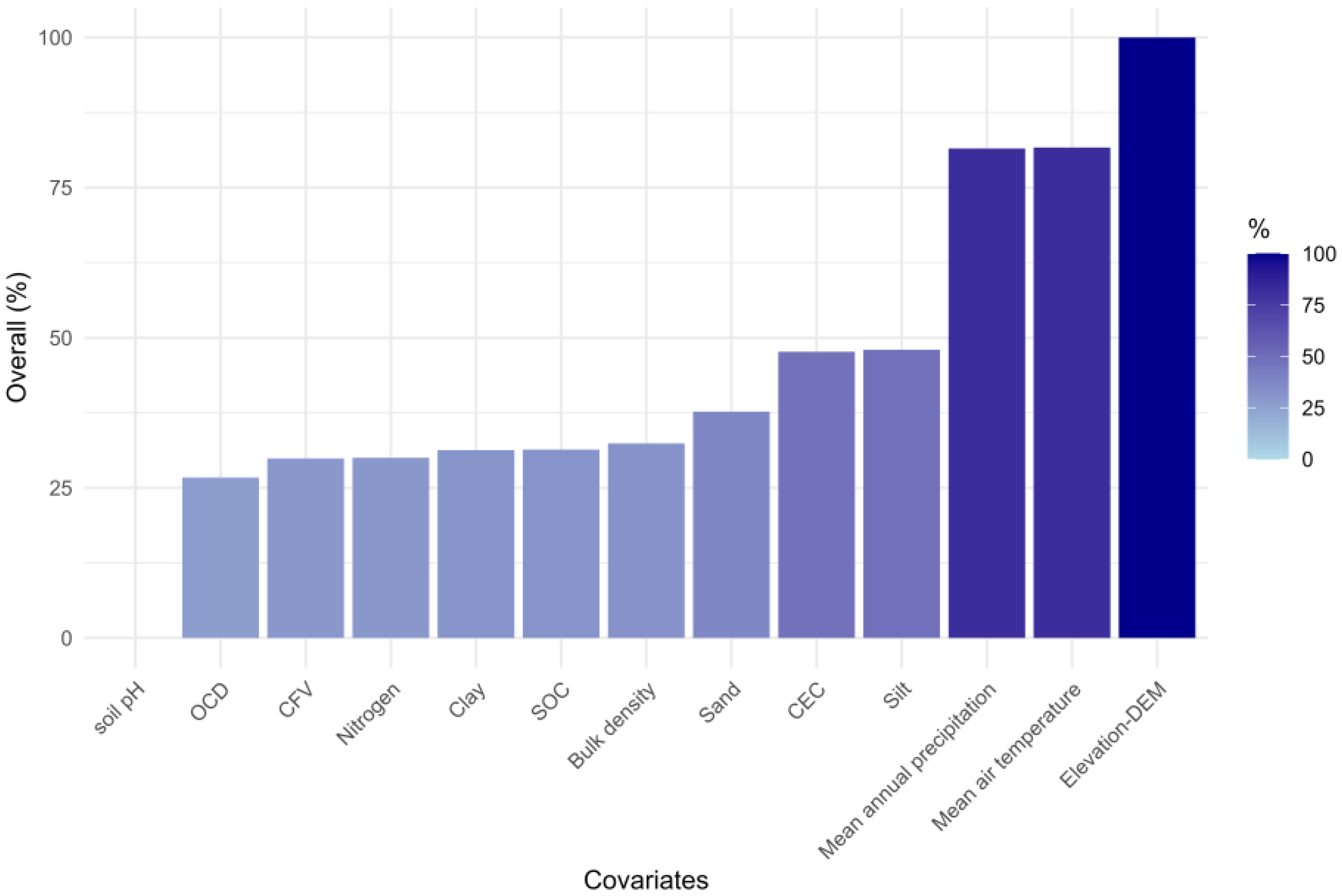
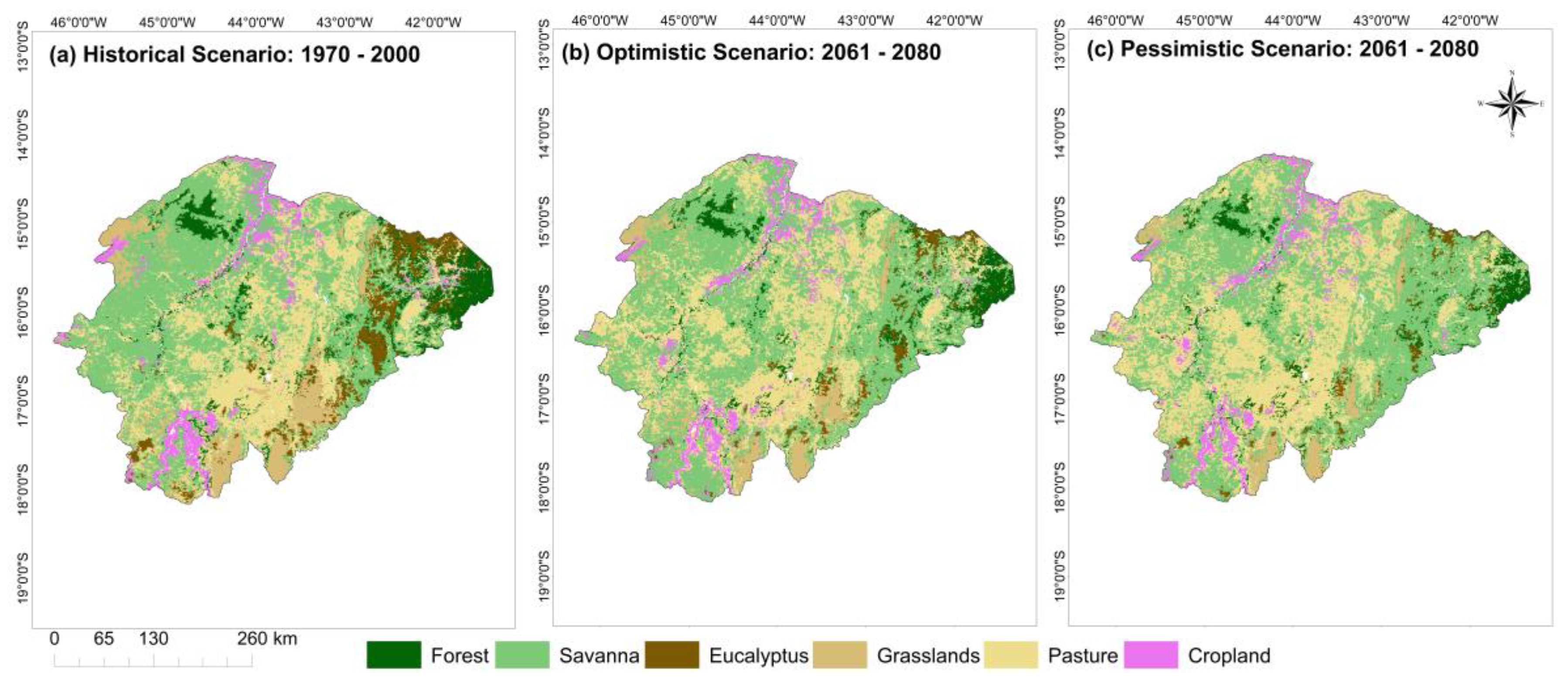

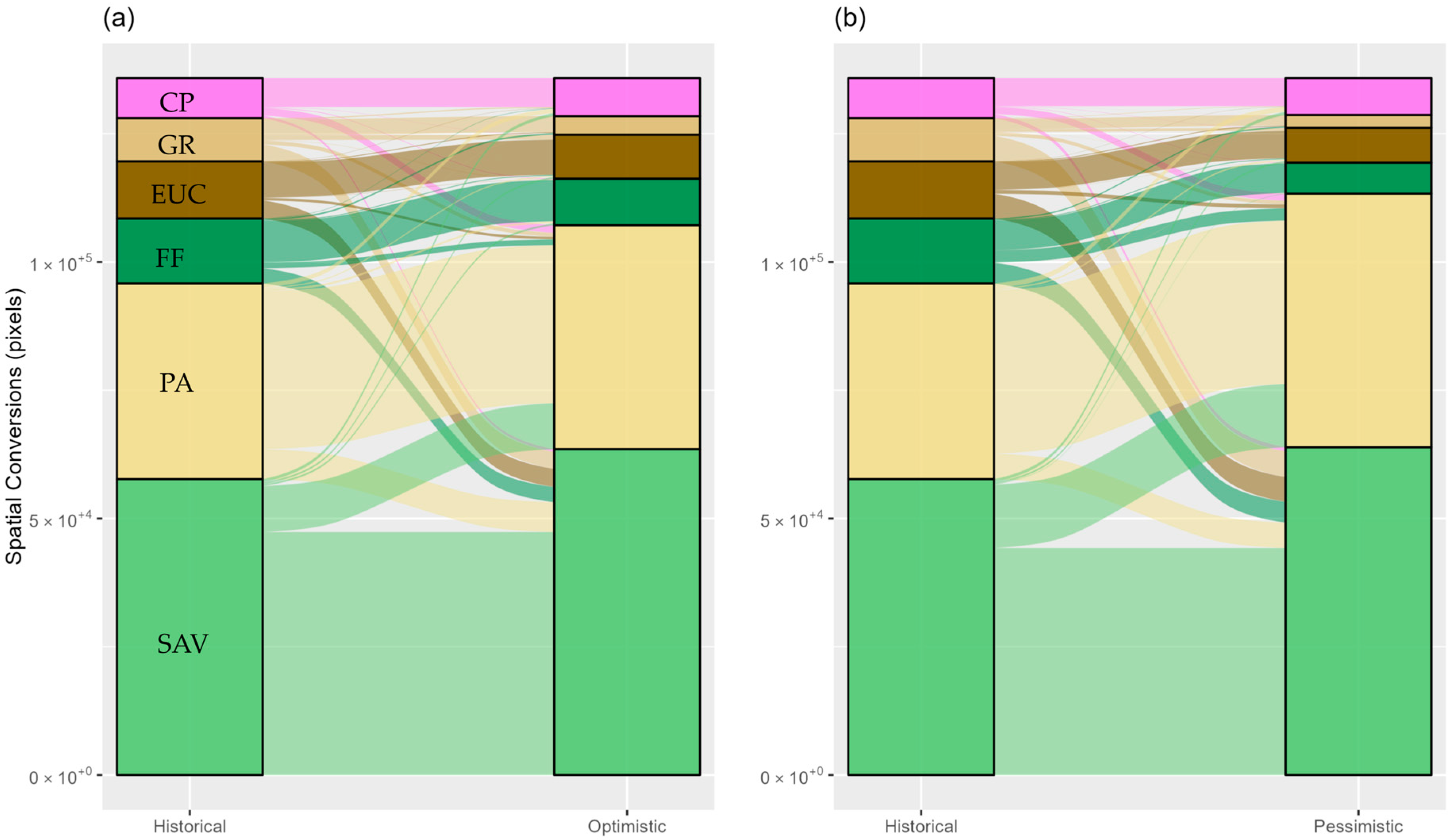
| Covariates | Resolution (m) | Period |
|---|---|---|
| Mean air temperature | 1000 | 1970–2000 and 2061–2080 |
| Annual precipitation | 1000 | 1970–2000 and 2061–2080 |
| Bulk density | 250 | 1970–2000 |
| Cation exchange capacity | 250 | 1970–2000 |
| Volumetric coarse fragment | 250 | 1970–2000 |
| Organic carbon density | 250 | 1970–2000 |
| Soil pH | 250 | 1970–2000 |
| Nitrogen | 250 | 1970–2000 |
| Soil organic carbon | 250 | 1970–2000 |
| Sand | 250 | 1970–2000 |
| Silt | 250 | 1970–2000 |
| Clay | 250 | 1970–2000 |
| Elevation | 30 | 1970–2000 |
| LULC | Description | Number of Samples |
|---|---|---|
| Forest | Vegetation with a predominance of tree species, with continuous canopy formation, and seasonal deciduous forests | 146 |
| Savanna | Savanna formations with trees, shrubs, and herbaceous strata | 307 |
| Eucalyptus | Tree species planted for commercial purposes. The typical planting space of eucalyptus (2 to 3 m between planting lines and 1 to 2 m between trees) | 134 |
| Grasslands | Natural formations with a predominance of a herbaceous layer and some shrubs | 222 |
| Pasture | Planted pastures, related to livestock activity (brachiaria; African genus Urochloa) | 252 |
| Croplands | Areas cultivated with perennial and temporary crops (bananas, grapes, lemons, mangoes, corn, and beans, among others) | 148 |
| Classes | Forest | Savanna | Eucalyptus | Grasslands | Pasture | Cropland | Total | UA (%) |
|---|---|---|---|---|---|---|---|---|
| Forest | 18 | 5 | 4 | 1 | 10 | 1 | 39 | 46.15 |
| Savanna | 3 | 51 | 6 | 5 | 21 | 8 | 94 | 54.26 |
| Eucalyptus | 0 | 3 | 22 | 0 | 2 | 0 | 27 | 81.48 |
| Grasslands | 1 | 12 | 1 | 40 | 2 | 0 | 56 | 71.43 |
| Pasture | 2 | 9 | 3 | 6 | 25 | 4 | 49 | 51.02 |
| Cropland | 2 | 7 | 0 | 1 | 3 | 24 | 37 | 64.86 |
| Total | 26 | 87 | 36 | 53 | 63 | 37 | ||
| PA (%) | 69.23 | 58.62 | 61.11 | 75.47 | 39.68 | 64.86 | ||
| OA (%) | 59.60 | |||||||
| AD (%) | 65.56 | |||||||
| QD (%) | 15.23 |
| LULC | Historical Data (km2) | RCP 2.6 (km2) | RCP 8.5 (km2) | Historical Data to RCP | |||
|---|---|---|---|---|---|---|---|
| 2.6 (km2) | 8.5 (km2) | 2.6 (%) | 8.5 (%) | ||||
| Croplands | 7803 | 7417 | 7192 | −386 | −611 | −4.95 | −7.83 |
| Eucalyptus | 8424 | 3616 | 2490 | −4808 | −5934 | −57.08 | −70.44 |
| Forest | 11,142 | 8572 | 6794 | −2570 | −4348 | −23.07 | −39.02 |
| Grasslands | 12,659 | 9070 | 6054 | −3589 | −6605 | −28.35 | −52.18 |
| Pasture | 38,130 | 43,650 | 49,421 | 5520 | 11,291 | 14.48 | 29.61 |
| Savanna | 57,681 | 63,514 | 63,888 | 5833 | 6207 | 10.11 | 10.76 |
Disclaimer/Publisher’s Note: The statements, opinions and data contained in all publications are solely those of the individual author(s) and contributor(s) and not of MDPI and/or the editor(s). MDPI and/or the editor(s) disclaim responsibility for any injury to people or property resulting from any ideas, methods, instructions or products referred to in the content. |
© 2024 by the authors. Licensee MDPI, Basel, Switzerland. This article is an open access article distributed under the terms and conditions of the Creative Commons Attribution (CC BY) license (https://creativecommons.org/licenses/by/4.0/).
Share and Cite
Silva, L.A.P.d.; Sano, E.E.; Parreiras, T.C.; Bolfe, É.L.; Espírito-Santo, M.M.; Filgueiras, R.; Souza, C.M.P.d.; Silva, C.R.d.; Leite, M.E. Climate Change Effects on Land Use and Land Cover Suitability in the Southern Brazilian Semiarid Region. Land 2024, 13, 2008. https://doi.org/10.3390/land13122008
Silva LAPd, Sano EE, Parreiras TC, Bolfe ÉL, Espírito-Santo MM, Filgueiras R, Souza CMPd, Silva CRd, Leite ME. Climate Change Effects on Land Use and Land Cover Suitability in the Southern Brazilian Semiarid Region. Land. 2024; 13(12):2008. https://doi.org/10.3390/land13122008
Chicago/Turabian StyleSilva, Lucas Augusto Pereira da, Edson Eyji Sano, Taya Cristo Parreiras, Édson Luis Bolfe, Mário Marcos Espírito-Santo, Roberto Filgueiras, Cristiano Marcelo Pereira de Souza, Claudionor Ribeiro da Silva, and Marcos Esdras Leite. 2024. "Climate Change Effects on Land Use and Land Cover Suitability in the Southern Brazilian Semiarid Region" Land 13, no. 12: 2008. https://doi.org/10.3390/land13122008
APA StyleSilva, L. A. P. d., Sano, E. E., Parreiras, T. C., Bolfe, É. L., Espírito-Santo, M. M., Filgueiras, R., Souza, C. M. P. d., Silva, C. R. d., & Leite, M. E. (2024). Climate Change Effects on Land Use and Land Cover Suitability in the Southern Brazilian Semiarid Region. Land, 13(12), 2008. https://doi.org/10.3390/land13122008











